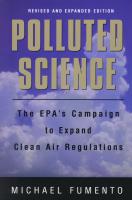Michael Fumento
Factual · Powerful · Original · Iconoclastic
Leaders & Success — Bruce Ames
January 01, 1999 · Michael Fumento · Epa The word has been out for the last few years in Washington: If you want your propaganda to penetrate, your bill to pass, your speech to be noted on the evening news, find some way by hook or by crook to tie it to children.
The word has been out for the last few years in Washington: If you want your propaganda to penetrate, your bill to pass, your speech to be noted on the evening news, find some way by hook or by crook to tie it to children.
Does it concern nursing homes? Tie it to children. How about Medicare? Tie it to children. Do you advocate giving a tax rebate to every American over the age of 90? Tie it to children. So how does the EPA keep its often oppressive and scientifically baseless power-grabbing going? Right, it ties it to children.
Two years ago, when the EPA was pushing regulations on emissions of small airborne particles that will eventually cost the nation $100s of billions, it initially admitted that they would essentially only effect older people who were already suffering respiratory disease. But late in the game it had a sudden revelation: Kids were in danger, too literally gasping to death in their cribs! The agency could now post the new regulations, safely in the knowledge that a cowed Congress dared not exercise its authority to challenge them at the risk of being labeled kiddie-killers.

I’m tired of being exploited for political gain — I’m outta here!
Now the EPA’s at it again. By amazing coincidence, just two days after the Clinton administration announced a $7.2 billion record-high budget proposal for the agency, the EPA published in the Federal Register the conclusions of a panel it established to look at what the EPA could do to save an allegedly endangered species. Yes, children.
You’d never know that by virtually every standard, American children are better off than ever. Malnutrition? Down. Childhood cancer? The incidence rate is stable; deaths are way down. Expectancy of living to adulthood? Up. Life expectancy overall? Up. Infant death rate, birth defects, and miscarriage rates? Down, down, down. IQ ratings? Up.
None of which is to say that there’s not still for improvement and that a wealthy society such as ours can’t afford it. The problem is, the EPA’s rump panel is advocating looking where the problems AREN’T and quite possibly making one of the real problems worse.
Probably the greatest problem our children have now is obesity. For those ages 12-17 it has more than doubled since the 1960s. For those ages 6-11, obesity incidence has almost tripled in that time. It’s bad for white kids, but even worse for black and Hispanic ones. The evidence is now also undeniable that childhood obesity leads to adult obesity and childhood obesity itself may cause permanent harm.
And while you can never say "never" when it comes to what area the EPA will try to wedge its bureaucratic tentacles into next, it’s hard to imagine the agency doing anything concerning overweight kids.
Another growing problem is asthma. The Centers for Disease Control and Prevention estimates 15 million Americans now suffer from it, with the number of doctor’s office visits doubling between 1975 and 1995. While old people are most likely to die from this ailment, children are far more likely to suffer from it. Asthma hospitalization rates are highest for children under age four. Blacks, especially inner-city ones, are hit hardest of all. Their hospitalization rate was over three times that of whites; their death rate over seven times higher.
With asthma such a problem for children and minorities, the EPA has desperately tried to get in on the act, blaming air pollution. But its own data show that U.S. air pollution levels have steadily declined even as asthma has skyrocketed. An international study released last year comprised 460,000 children in 56 countries and with amazing consistency found asthma rates highest in the countries with the LEAST air pollution.
To blame air pollution "is political, not medical," says Dr. David Rosenstreich, primary author of a study on asthma causes published in the New England Journal of Medicine in 1997. His team found the disease’s primary cause is actually the species we know as cockroachus disgustingus. Specifically, it’s from what an EPA bureaucrat might call cockroach "tailpipe emissions."

What’s the best way to reduce childhood asthma, then? To paraphrase Shakespeare: "First let’s kill all the roaches."
Yet one of the areas the EPA panel is looking into could lead to a ban on those insecticides most effective against these scurrying scourges. This includes one class of insecticide known as organophosphates, and another called carbamates. Both are potent cockroach killers, even as 30 years’ use has shown them to have low toxicity to children.
As with obesity, there’s little the EPA can do to help with asthma. But at least with fatness it doesn’t have a panel pondering recommendations to make the situation worse.
In short, the greatest problems of children lie outside EPA jurisdiction. It can and may hurt, but it cannot and will not help. We should not allow this agency to distract us in order to pad its budget, give it undeserved credibility, and expand its already vast domain by hiding behind the skirts and short pants of our most precious natural resource.
